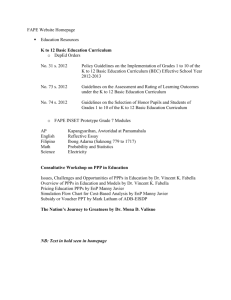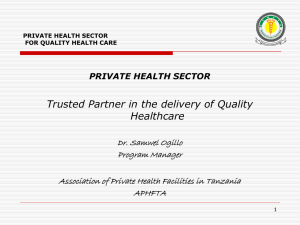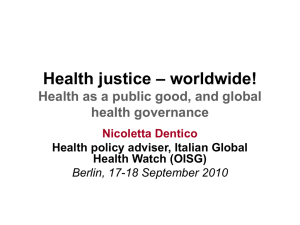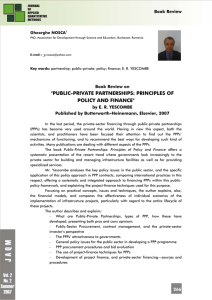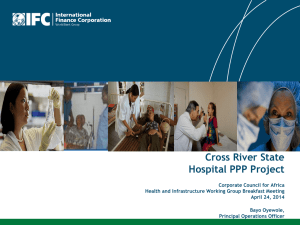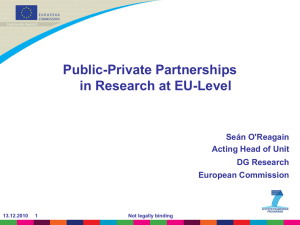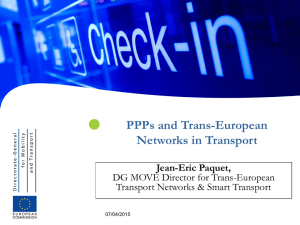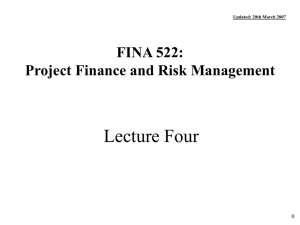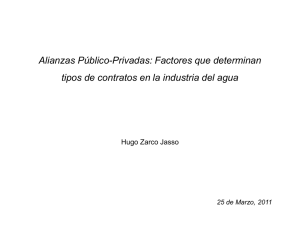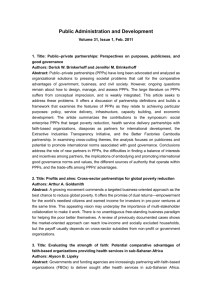Understanding the Emerging Role of the Private Sector in Medical
advertisement
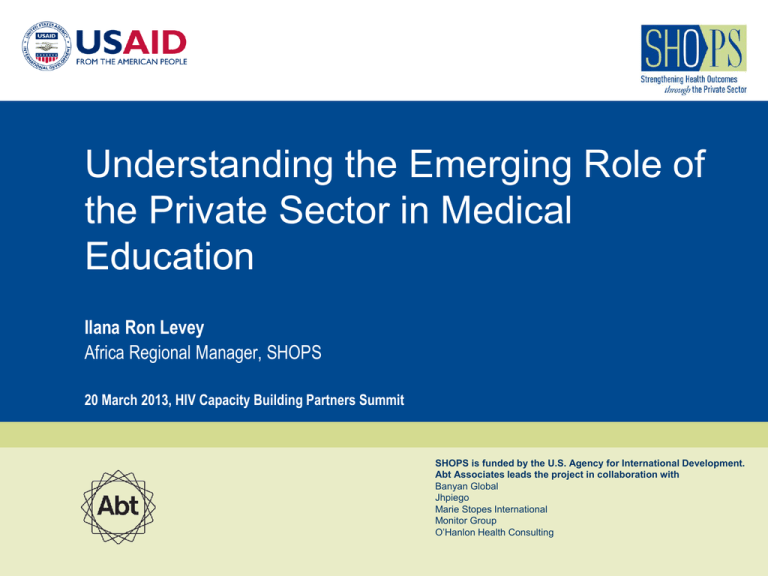
Understanding the Emerging Role of the Private Sector in Medical Education Ilana Ron Levey Africa Regional Manager, SHOPS 20 March 2013, HIV Capacity Building Partners Summit SHOPS is funded by the U.S. Agency for International Development. Abt Associates leads the project in collaboration with Banyan Global Jhpiego Marie Stopes International Monitor Group O’Hanlon Health Consulting Overview of the Session • Setting the context about the role of the private sector in health service delivery • Understanding more about the emerging role of the private sector in medical education • Focusing on financial and business challenges • Personal reflections from private medical training institution proprietors Three Common Myths about the Private Health Sector Myth #1: Health in Africa is financed primarily by the public sector Health Financing in Africa Source: Marek T, et al. 2005 Private Sector Expenditures in Africa Where Health Funds Come From Public ~~40% 40% $8.3 B Public Providers $16.7B 100% Where Private Funds Are Spent ~ 65% ~ 50% Private ~65% For profit ~ 50% Other private Private prepaid Source of payment Healthcare Expenditure by Financing Agent (%) Source: IFC Report, 2007 Private Providers Out of pocket $4.2B ~ 50% ~50% ~50% Providers Social enterprise ~~15% 15% Non profit ~~10% 10% Traditional healers ~~10% 10% Private sector providers Healthcare Expenditure by Provider Ownership (%) Private Financing Trends • Over half of total health expenditures for households are in the private sector • Private sector health expenditure is generally in the form of direct payments at the point of service • Out-of-pocket health expenditures has increased in both absolute and relative terms • Some evidence that donor funding may be affecting private investment in HIV Source: AFD Diagnostic forthcoming Three Common Myths about the Private Health Sector Myth #2: The private health sector mostly benefits the wealthy All Population Segments, Including the Poor, Access the Private Health Sector % 74% Use of private sector among POOREST QUINTILE in Sub-Saharan Africa for curative child care 49% 7% Source: SARA Project 2004 The For-profit Private Sector Provides Care Across all Income Groups Urban and Rural Population Receiving Care from Private for-Profit Provider of Modern Medicine Lowest quintile Highest quintile *Percent: Most recent survey year available between 1995-2006 Source: WB Africa Development Indications 2006, team analysis Three Common Myths about the Private Health Sector Myth #3: The private health sector is insignificant in Africa Virtually Half of all Physicians Work in the Private Health Sector in Africa Geographic Region % of physicians Asia working (6 countries) 60% Sub-Saharan Africa (8 countries) Mali the private sector Kenya 46% Latin American & Caribbean (5 countries) 46% North African & Middle East (7 countries) 35% Source: Marek, T. Presentation in South Africa 2005, WB 2005, IFC Country Assessments of the Private Health Sector 50% 74% in Private-for-profit Providers are a Sizable Source for HIV Testing in Africa Source: Most recent Demographic and Health Surveys (DHS) and AIDS Indicator Surveys (AIS) Even Higher Reliance on Private Health Sector for STI Care Source: Most recent Demographic and Health Surveys (DHS) and AIDS Indicator Surveys (AIS) Private Healthcare Market in Africa Expected to Double by 2016 40,000 Actual Projections $35B 35,000 30,000 25,000 Private Health expenditures $13.5B 20,000 Total health expenditures 15,000 10,000 5,000 ($ million) 2016 2015 2014 2013 2012 2011 2010 2009 2008 2007 2006 2005 2004 2003 2002 2001 2000 1999 1998 1997 1996 0 Actual values for 1996 – 2005; projections for 2005 – onward Source: IFC Report, 2007 Moving from Service Delivery to HRH: The Private Sector Role in Medical Education Private Sector Actors in Each Building Block of the Health System Source: Arur A. et al. 2010. Strengthening Health Systems by Engaging the Private Health Sector: Promising HIV/AIDS Partnerships. SHOPS Project, Abt Associates. Setting the Stage • Globally, the share of total enrollment in private tertiary education in 30 percent • Asia is the region with the highest level of private tertiary enrollment (e.g., Philippines at 75 percent) • Growth in private medical tertiary education in Africa in the context of stronger emphasis for preservice education Greater Linkages with the Public Sector in the Education Sphere • Partnerships between the public and private sectors are more of a norm in medical education than in service delivery • Few purely private models of private education→ high interdependence • Public-private partnership (PPP) in medical education is a formal collaboration with any level of government and the private sector to jointly regulate, finance or deliver medical education Public and Private Actors in Medical Education PUBLIC • Ministries of Health and Education • Professional Councils • Public Universities and Training Institutes • Public Teaching Hospitals PRIVATE • For-profit or not-for-profit Universities, Teaching Hospitals, and Training Institutes (PMTI) • Associations of Private Training Institutes • Research Organizations • Management Consultancies The Public/Private Mix in Medical Education Ownership / Delivery PRIVATE Financing PUBLIC PUBLIC Traditional public institutions - Private institutions that receive government support Subsidized or no tuition fees - Public institutions with private cost-sharing - PRIVATE Tuition fees Student loans Private contributions Contracting out Targeted vouchers Tax incentives Transfer payments or subsidized loans Independent private institutions (forprofit and not-for profit) - Tuition fees Student loans Private contributions, equity or debt Types of PPPs in Medical Education • Contractual or “contracting out” • Legal requirements or tax incentives • Supply-side subsidies • Demand-side subsidies • Sale of public assets • Voluntary or philanthropic partnerships • Medical education franchising Some Emerging Lessons • PPPs in medical education are nascent compared to service delivery • Growth of PMTI is a precursor to PPPs→ many barriers to the growth of PMTI in Africa still exist • Effective student loan initiatives require the sharing of risk between public and private stakeholders and can benefit from innovative PPPs • Major gaps in the adequate flow of information from the private education market to consumers Ilana Ron Levey ilana_ron@abtassoc.com www.shopsproject.org SHOPS is funded by the U.S. Agency for International Development. Abt Associates leads the project in collaboration with Banyan Global Jhpiego Marie Stopes International Monitor Group O’Hanlon Health Consulting Wrapping It All Up • There is significant potential for the growth of private medical education and PPPs • However, there are major challenges- particularly around financial and business issues- facing private medical education • Other issues around private medical education including quality of instruction; accreditation systems; and regulatory environment differ across Africa→ hard to generalize • Often need to dig deep to the institution-level to truly understand the landscape Eager to Hear from the Audience • What are the main challenges in private medical education in your country? • Do you think the private sector has been adequately incorporated into human resources for health efforts? Why or why not?

